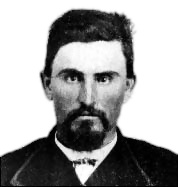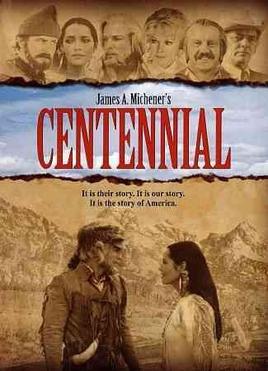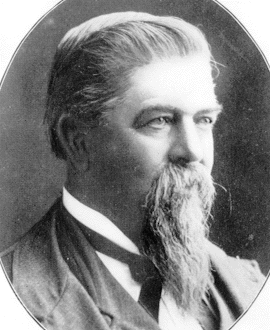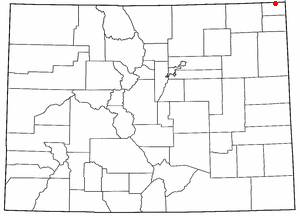
Weld County is a county located in the U.S. state of Colorado. As of the 2020 census, the population was 328,981. The county seat is Greeley.

Larimer County is a county located in the U.S. state of Colorado. As of the 2020 census, the population was 359,066. The county seat and most populous city is Fort Collins. The county was named for William Larimer, Jr., the founder of Denver.

The City of Evans is a home rule municipality located in Weld County, Colorado, United States. The city population was 22,165 at the 2020 United States Census, a 19.57% increase since the 2010 United States Census. Evans is a part of the Greeley, CO Metropolitan Statistical Area and the Front Range Urban Corridor.

The City of Fort Lupton is a Statutory City located in southern Weld County, Colorado, United States. The town population was 7,955 at the 2020 United States Census. Fort Lupton is a part of the Greeley, Colorado Metropolitan Statistical Area and the Front Range Urban Corridor.

Greeley is the home rule municipality city that is the county seat and the most populous municipality of Weld County, Colorado, United States. The city population was 108,795 at the 2020 United States Census, an increase of 17.12% since the 2010 United States Census. Greeley is the tenth most populous city in Colorado. Greeley is the principal city of the Greeley, CO Metropolitan Statistical Area and is a major city of the Front Range Urban Corridor. Greeley is located in northern Colorado and is situated 49 miles (79 km) north-northeast of the Colorado State Capitol in Denver.

The Sand Creek massacre was a massacre of Cheyenne and Arapaho people by the U.S. Army in the American Indian Wars that occurred on November 29, 1864, when a 675-man force of the Third Colorado Cavalry under the command of U.S. Volunteers Colonel John Chivington attacked and destroyed a village of Cheyenne and Arapaho people in southeastern Colorado Territory, killing and mutilating an estimated 69 to over 600 Native American people. Chivington claimed 500 to 600 warriors were killed. However, most sources estimate around 150 people were killed, about two-thirds of whom were women and children. The location has been designated the Sand Creek Massacre National Historic Site and is administered by the National Park Service. The massacre is considered part of a series of events known as the Colorado Wars.

James Albert Michener was an American writer. He wrote more than 40 books, most of which were long, fictional family sagas covering the lives of many generations, set in particular geographic locales and incorporating detailed history. Many of his works were bestsellers and were chosen by the Book of the Month Club; he was known for the meticulous research that went into his books.

Charles Goodnight, also known as Charlie Goodnight, was a rancher in the American West. In 1955, he was inducted into the Hall of Great Westerners of the National Cowboy & Western Heritage Museum.

The region that is today the U.S. State of Colorado has been inhabited by Native Americans and their Paleoamerican ancestors for at least 13,500 years and possibly more than 37,000 years. The eastern edge of the Rocky Mountains was a major migration route that was important to the spread of early peoples throughout the Americas. The Lindenmeier site in Larimer County contains artifacts dating from approximately 8720 BCE.

Centennial is a 12-episode American television miniseries that aired on NBC from October 1978 to February 1979. The miniseries follows the fictional history of Centennial, Colorado, from 1795 to the 1970s. It was based on the 1974 novel of the same name by James A. Michener, was produced by John Wilder.

The Territory of Colorado was an organized incorporated territory of the United States that existed from February 28, 1861, until August 1, 1876, when it was admitted to the Union as the State of Colorado.

Benjamin Harrison Eaton was an American politician, entrepreneur and agriculturalist in the late 19th and early 20th century. Eaton was a founding officer of the Greeley Colony and was instrumental in the establishment of modern irrigation farming to Northern Colorado. A member of the Republican Party, he served as the fourth Governor of Colorado, from January 1885 to January 1887, with the nickname of the "farmer governor". He was one of the largest land owners in Weld and Larimer counties, at one time owning over ninety 160 acre (0.6 km²) parcels, all watered from canals and reservoirs of his own construction. His projects were influential in helping turn the South Platte River valley into an important agricultural region in the state's economy. The town of Eaton, Colorado in western Weld County is named for him.
The Colorado Piedmont is an area along the base of the foothills of the Front Range in north central Colorado in the United States. The region consists of a broad hilly valley, just under 5000 ft in elevation, stretching north and northeast from Denver in the valley of the South Platte River, as well as along the Arkansas River valley southward from Colorado Springs. The name Colorado Piedmont also refers to the physiographic section of the Great Plains province.

The Colorado War was an Indian War fought in 1864 and 1865 between the Southern Cheyenne, Arapaho, and allied Brulé and Oglala Sioux peoples versus the U.S. Army, Colorado militia, and white settlers in Colorado Territory and adjacent regions. The Kiowa and the Comanche played a minor role in actions that occurred in the southern part of the Territory along the Arkansas River. The Cheyenne, Arapaho, and Sioux played the major role in actions that occurred north of the Arkansas River and along the South Platte River, the Great Platte River Road, and the eastern portion of the Overland Trail. The United States government and Colorado Territory authorities participated through the 1st Colorado Cavalry Regiment, often called the Colorado volunteers. The war was centered on the Colorado Eastern Plains, extending eastward into Kansas and Nebraska.
Mari Yoriko Sabusawa was a translator, activist, and philanthropist. She was the third wife of novelist James A. Michener, whom she married on October 23, 1955, in Chicago, Illinois.

Orchard is an unincorporated town, a post office, and a census-designated place (CDP) located in and governed by Morgan County, Colorado, United States. The CDP is a part of the Fort Morgan, CO Micropolitan Statistical Area. The Orchard post office has the ZIP Code 80649. As of the 2020 census, the population of the Orchard CDP was 76.

The Goodnight–Loving Trail was a trail used in the cattle drives of the late 1860s for the large-scale movement of Texas Longhorns. It is named after cattlemen Charles Goodnight and Oliver Loving.

The Battle of Julesburg took place on January 7, 1865, near Julesburg, Colorado between 1,000 Cheyenne, Arapaho, and Lakota Indians and about 60 soldiers of the U.S. army and 40 to 50 civilians. The Indians defeated the soldiers and over the next few weeks plundered ranches and stagecoach stations up and down the South Platte River valley.

South Platte Trail was a historic trail that followed the southern side of South Platte River from Fort Kearny in Nebraska to Denver, Colorado. Plains Indians, such as the Cheyenne and the Arapaho, hunted in the lands around the South Platte River. They also traded at trading posts along the route, as did white travelers. Travelers included trappers, traders, explorers, the military, and those following the gold rush. The trail was also used by the Pony Express.

Fort Wicked was a ranch and stage station on the Overland Trail from 1864 to 1868 in present-day Merino, Colorado. A historical marker commemorating the ranch is located at US 6 and CR-2.5. The ranch itself was located near a ford of the South Platte River, near where US-6 now crosses over the river. Fort Wicked was one of the few places along the trail to Denver that withstood an attack by Lakota, Cheyenne, and Arapaho Native Americans in the Colorado War of 1864. It was named Fort Wicked for the "bitter defence" made by Holon Godfrey, his family, and his employees.
















